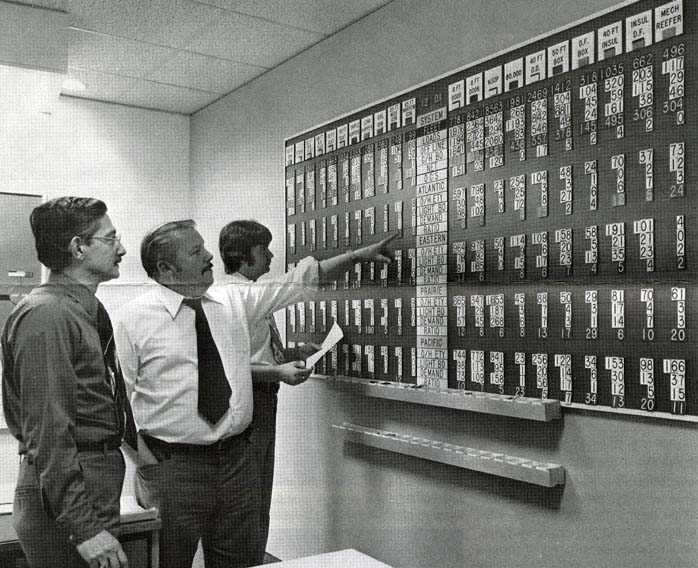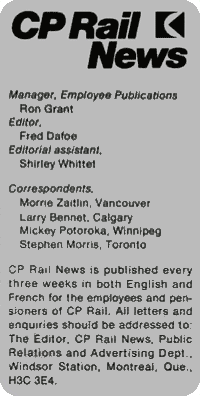
Number 3
February 27, 1980
Aids System Nerve Centre

across the system on this board in the equipment control centre. The board is updated daily.
Montreal - Space-age technology is being combined with old-fashioned railway know-how to create a centralized car control system that substantially improves freight car utilization and distribution to customers.
From an operations nerve centre called system car management in the railway's Montreal headquarters, the information storage and quick access capabilities of the computer world help CP Rail's transportation department to monitor thousands of cars around the clock, forecast demand, and prepare weekly car distribution plans.
"The system car management centre is designed around the theory that the empty car in demand is just as important as the loaded car," said J.H. Geddis, chief of transportation. "Today the empty freight car enjoys the status of a corporate asset because that's the car available to meet customer demand."
The new system has been responsible for a steady improvement in car utilization. This year, the first full year of operation for the car management centre, overall car utilization is expected to improve by five percent based on performance figures for the first six months of 1979.
To get the nearest available car to a shipper, the 69,000 freight car fleet is monitored around the clock, along with the 10,000 foreign cars on the railway's system at any given time. Monitoring is done from the more than dozen computer terminals in the car management centre.
The computer terminals, linked with customer service centres throughout the country and with car distribution centres in key locations, keep car management staff up-to-date on supply and demand at the touch of a button.
The distribution centres provide a destination for every empty car in the fleet, sending cars from areas where they are in surplus to where they are in demand. The car movements follow a weekly distribution plan based on a demand-and-supply forecast from the car management centre in Montreal.
Recently the railway took the empty car distribution system a step further with the introduction of XT trains, high-priority empty freight trains. The XT, the first of its kind in Canada, is designed for the quick retrieval of empty cars from Western Canada.
Averaging 90 cars in length and leaving five times weekly from the Vancouver terminal bound for Toronto, the XT trains, in only a few months of full operation, have reduced critical transit time of empty equipment by up to 25 percent.
Meanwhile, the empty freight car fleet is tracked on a 36-foot-wide, color-coded, magnetic board in the equipment control section of the car management centre. The board is a scale model of the railway network and is divided into four regions with their corresponding time zones.
It is updated by staff at regional control desks who co-ordinate movement of cars between regions to meet demand for the fleet.
As well, separate monitoring sections for specialized equipment such as covered hoppers and automotive cars are responsible for ensuring top utilization of high-demand equipment.
 While computer technology has improved day-to-day car utilization, its information storage capability has also enabled
the railway to perform accurate analysis of long-term performance by car type.
While computer technology has improved day-to-day car utilization, its information storage capability has also enabled
the railway to perform accurate analysis of long-term performance by car type.
"It's important to know how many trips you managed to get from a car type. But, just as important is to establish the productivity we expect down the road," said Mr. Geddis.
The car maintenance program has also contributed to the improved fleet utilization. A systematic monthly maintenance program reduces unexpected bad orders by scheduling regular repairs in main shops for car types.
"The result of the tight fleet control and planning procedures under the system car management centre approach is we get more done with fewer cars. And it means we are better prepared to meet shipper demand," said Mr. Geddis.

